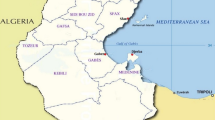Abstract
Bangladesh is home to diverse rice germplasm, including red rice, many of which are preferred for cultivation by farmers over high-yielding rice varieties due to their special characteristics, color, taste, and nutritional value. Red color of seed pericarp is unusual among modern cultivated varieties, though it is a common characteristic in wild relatives of rice, making the trait an important parameter when studying the domestication and evolution of crop plants. Diversity analysis using microsatellite markers and sequence variation of the red rice loci of the indigenous rice population in Bangladesh was therefore performed. Microsatellite fingerprinting could successfully cluster cultivars according to their specific phenotypic characteristics such as stickiness or aroma, irrespective of their pericarp color, and locate a set of unique identifiers. Sequence analysis of a portion of the bHLH transcription factor gene Rc, which controls the red pigment, confirmed the occurrence of the 14-bp deletion in white rice accessions which has been reported previously. The analysis included a group of rice cultivars which are known by the same name but produce two different colored seeds and are indistinguishable morphologically unless dehusked. Statistical and internal transcribed spacer region sequence diversity analyses established that such cultivars, although genetically different, had very low diversity, suggesting a close evolutionary relationship between them. Red and white seeds from cultivars with the same name were planted individually over two generations and dehusked to check for loss/gain of pigmentation. Red-seeded plants produced some dirty-white seeds in addition to red ones in the first generation, the proportion of which increased when planted in the successive generation. This loss in pigment was probably due to faulty transcription, since no deletion in the respective region of the genome of the dirty-white seeds was noted.



Similar content being viewed by others
References
Brooks SA, Yan W, Jackson AK, Deren CW (2008) A natural mutation in rc reverts white-rice-pericarp to red and results in a new, dominant, wild-type allele: Rc-g. Theor Appl Genet 117(4):575–580. doi:10.1007/s00122-008-0801-8
Chung MC, Lee YI, Cheng YY, Chou YJ, Lu CF (2008) Chromosomal polymorphism of ribosomal genes in the genus oryza. Theor Appl Genet 116(6):745–753. doi:10.1007/s00122-007-0705-z
Dipti SS, Bari MN, Kabir KA (2003) Grain quality characteristics of some beruin rice varieties of bangladesh. Pak J Nutr 2(4):242–245. doi:10.3923/pjn.2003.242.245
Dong Y, Xu J, Xiao K, Zhang Y, Zhang J, Luo L, Matsuo M (2008) Genomic regions associated with the degree of red coloration in pericarp of rice (oryza sativa l). J Cereal Sci 48 (2):556-560 doi:10.1016/j.jcs.2007.11.011
Doyle J, Doyle J (1987) A rapid DNA isolation procedure for small quantities of fresh leaf tissue. Phytochem Bull 19:11–15
Furukawa T, Maekawa M, Oki T, Suda I, Iida S, Shimada H, Takamure I, Kadowaki K (2007) The rc and rd genes are involved in proanthocyanidin synthesis in rice pericarp. Plant J 49(1):91–102. doi:10.1111/j.1365-313X.2006.02958.x
Hall (1999) Bioedit: a user-friendly biological sequence alignment editor and analysis program for windows 95/98/nt. Nucleic Acids Symp Ser 41:95–98
Jaccard P (1908) Nouvelles recherches sur la distribution florale. Bull Soc Vaud Sci Nat 44:223–270
Kinoshita (1995) Report of committee on gene symbolization, nomenclature and linkage groups. Rice Genet Newsl 12:9–153
Kovach MJ, Sweeney MT, McCouch SR (2007) New insights into the history of rice domestication. Trends Genet 23(11):578–587. doi:10.1016/j.tig.2007.08.012
Lee D, Lupotto E, Powell W (2009) G-string slippage turns white rice red. Genome 52(5):490–493. doi:10.1139/g09-025
Lisa LA, Seraj ZI, Elahi CMF, Das KC, Biswas K, Islam MR, Salam MA, Gomosta AR (2004) Genetic variation in microsatellite DNA, physiology and morphology of coastal saline rice (oryza sativa l.) landraces of bangladesh. Plant Soil 263:213–228
Nei M (1973) Analysis of gene diversity in subdivided populations. Proc Natl Acad Sci USA 70(12):3321–3323
Oka HI (1958) Intervarietal variation and classification of cultivated rice. Ind J Genet Pl Breed 18:79–89
Petrov DA, Hartl DL (2000) Pseudogene evolution and natural selection for a compact genome. J Hered 91(3):221–227
Rohlf (2000) Statistical power comparisons among alternative morphometric methods. Am J Phys Anthropol 111:463–478
Sneath Sokal (1973) Numerical taxonomy. Freeman, San Francisco
Sweeney MT, Thomson MJ, Pfeil BE, McCouch S (2006) Caught red-handed: Rc encodes a basic helix-loop-helix protein conditioning red pericarp in rice. Plant Cell 18(2):283–294. doi:10.1105/tpc.105.038430
Sweeney MT, Thomson MJ, Cho YG, Park YJ, Williamson SH, Bustamante CD, McCouch SR (2007) Global dissemination of a single mutation conferring white pericarp in rice. PLoS Genet 3(8):e133. doi:10.1371/journal.pgen.0030133
Tamura K, Dudley J, Nei M, Kumar S (2007) Mega4: molecular evolutionary genetics analysis (mega) software version 4.0. Mol Biol Evol 24(8):1596–1599. doi:10.1093/molbev/msm092
Thompson JD, Gibson TJ, Higgins DG (2002) Multiple sequence alignment using clustalw and clustalx. Curr Protoc Bioinformatics Chapter 2:Unit 2 3. doi:10.1002/0471250953.bi0203s00
Yap IV, Nelson RJ (1996) Winboot: a program for performing bootstrap analysis of binary data to determine the confidence limits of UPGMA based dendrograms IRRI (Int Rice Res Inst). Discussion Paper Series 14
Acknowledgments
This work was supported by grants from the Bangladesh chapter of the US Department of Agriculture (USDA). The authors cordially thank Dr. Abdul Chaudhury (Vitagrain, Singapore) and Mr. Munir Hasan (General Secretary Bangladesh Math Olympiad and consultant to the Ministry of Science and ICT) for collections of the seeds from farmers and encouragement to undertake this work.
Author information
Authors and Affiliations
Corresponding author
Electronic supplementary material
Below is the link to the electronic supplementary material.
Rights and permissions
About this article
Cite this article
Elias, S.M., Mahbub Hasan, A.K.M. & Seraj, Z.I. Microsatellite marker diversity and sequence polymorphism in the red gene locus of indigenous rice populations of Bangladesh. Plant Syst Evol 296, 157–165 (2011). https://doi.org/10.1007/s00606-011-0482-7
Received:
Accepted:
Published:
Issue Date:
DOI: https://doi.org/10.1007/s00606-011-0482-7




